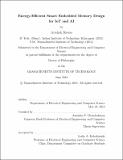Energy-efficient smart embedded memory design for IoT and AI
Author(s)
Biswas, Avishek, Ph. D. Massachusetts Institute of Technology
DownloadFull printable version (5.563Mb)
Other Contributors
Massachusetts Institute of Technology. Department of Electrical Engineering and Computer Science.
Advisor
Anantha P. Chandrakasan.
Terms of use
Metadata
Show full item recordAbstract
Static Random Access Memory (SRAM) continues to be the embedded memory of choice for modern System-on-a-Chip (SoC) applications, thanks to aggressive CMOS scaling, which keeps on providing higher storage density per unit silicon area. As memory sizes continue to grow, increased bit-cell variation limits the supply voltage (Vdd) scaling of the memory. Furthermore, larger memories lead to data transfer over longer distances on chip, which leads to increased power dissipation. In the era of the Internet-of-Things (IoT) and Artificial Intelligence (AI), memory bandwidth and power consumption are often the main bottlenecks for SoC solutions. Therefore, in addition to Vdd scaling, this thesis also explores leveraging data properties and application-specfic features to design more tailored and "smarter" memories. First, a 128Kb 6T bit-cell based SRAM is designed in a modern 28nm FDSOI process. Dynamic forward body-biasing (DFBB) is used to improve the write operation, and reduce the minimum Vdd to 0.34V, even with 6T bit-cells. A new layout technique is proposed for the array, to reduce the energy overhead of DFBB and decrease the unwanted bit-line switching for un-selected columns in the SRAM, providing dynamic energy savings. The 6T SRAM also uses data prediction in its read path, to provide upto 36% further dynamic energy savings, with correct predictions. The second part of this thesis, explores in-memory computation for reducing data movement and increasing memory bandwidth, in data-intensive machine learning applications. A 16Kb SRAM with embedded dot-product computation capability, is designed for binary-weight neural networks. Highly parallel analog processing in- side the memory array, provided better energy-efficiency than conventional digital implementations. With our variation-tolerant architecture and support of multi-bit resolutions for inputs/outputs, > 98% classication accuracy was demonstrated on the MNIST dataset, for the handwritten digit recognition application. In the last part of the thesis, variation-tolerant read-sensing architectures are explored for future non-volatile resistive memories, e.g. STT-RAM.
Description
Thesis: Ph. D., Massachusetts Institute of Technology, Department of Electrical Engineering and Computer Science, 2018. This electronic version was submitted by the student author. The certified thesis is available in the Institute Archives and Special Collections. Cataloged from student-submitted student-submitted PDF version of thesis. Includes bibliographical references (pages 137-146).
Date issued
2018Department
Massachusetts Institute of Technology. Department of Electrical Engineering and Computer SciencePublisher
Massachusetts Institute of Technology
Keywords
Electrical Engineering and Computer Science.